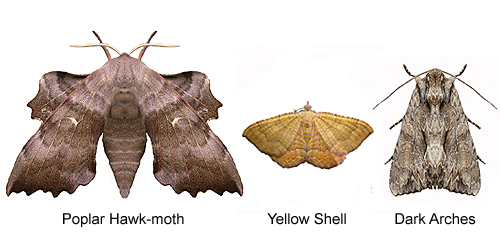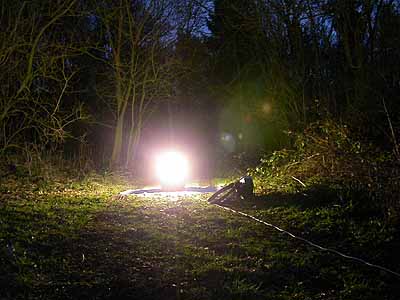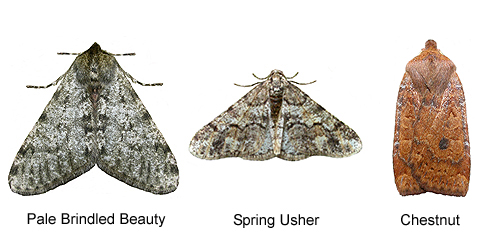

| A beginners guide to moths and moth trapping |
| (Ten common Nottinghamshire moths by month) |
| I personally developed an interest in moths many years ago, with Dilys developing her interest after we married in 2005. Originally, this interest centred around breeding and rearing of some of our native hawk-moths, but this lapsed in the mid-1980's and it took many more years before an interest in moths was rekindled again. This time the interest concerned moths found within the Eakring area and broadened to include both micro and macro moths. | ||
| ..... | ||
 |
The study
eventually came to occupy a large percentage of the time
we now spend out in the field and expanded in 2008 to
include regular trapping sessions within Sherwood Forest.
Observing and recording moths can become inherently addictive to anyone with an interest in natural history - a fact that we can testify to. It is also an important and still largely neglected interest, but has gained popularity in recent years. Although Nottinghamshire is generally well-covered as a whole, with an increasing number of people recording moths, there is still a lot of work to be done to create an accurate picture of the county's micro lepidoptera. |
|
| ............... | ||
| Observing moths There are many ways which people can observe or attract moths. Day-flying species are relatively easy to observe in the correct habitat, but species variety is quite restricted. More species start flying during the late evening period before it gets dark and these can be netted for identification purposes and then released. Quite a number of the records we gather during the year, involve moths found at rest on tree trunks, fences and walls. In fact, two out of Eakring's three Red Underwing records, came courtesy of the local pub wall. Moths can also be found in the early stages of their life-cycle as caterpillars or pupae on their respective foodplants. Sugaring is another method of attracting adult moths, but not a method we have ever tried. A mixture of Black Treacle and Red Wine, is boiled together and left to cool, then painted in strips on fence posts and tree trunks etc. Apparently it works better during the Autumn and early Spring. Putting a name to any moth one comes across is not always easy and there are currently well over 2000 species of moths in the UK. Back in 2003 we believed that the Eakring and Kersall area should comfortably hold around 400 - 500 different species of both micro and macro moths. Currently (2012) the area list stands at just over 650 species. Progress was slow up until 2003, when we began to trap moths with the aid of a portable camping lantern. |
||
| ............... |
| Trapping with a portable lantern Before the availability of an MV light, a great deal of time was spent looking around for a portable (and suitable) light to at least make some progress in attracting more species than had been possible previously. Initial trials using a portable, battery operated lantern made by Coleman, an American-based company, were successful. The lantern used two 4 watt .6" standard flourescent tubes, powered by a rechargeable battery, which (the makers claim) can be recharged up to 1000 times before replacement. The whole lantern was encased inside a tough perspex cover, providing either 180 or 360 degree lighting and allows single or double bulb use. The lantern could run for six hours operating both bulbs, or nine hours running a single bulb. It's also light-weight, easily portable and the £30 price is little in comparison to the expense of portable MV set-ups. It is certainly a set up that could be recommended for someone completely new to the hobby. |
| ............... | ||
 |
First
trials began in early March 2003, running the light sat
on a white ground sheet. It's a time of year when
relatively few moths are on the wing, but initial
trapping sessions in Lound Wood proved a success,
attracting several sought-after early species'. Trials continued throughout the year and trapping with such a light certainly proved to be much better than expected, with well over 1000 moths attracted during the course of the year. Although nightly trapping counts were small in comparison to the greater potential of an MV light, it was still a big step forward into discovering just what species the area's habitats held. Moth-trapping with a Mercury Vapour light 2004 saw even greater steps into attracting and identifying the moths here; with the building of a 125W Mercury Vapour light trap. |
|
| ............... | ||
| After spending many nights during 2003
trapping moths with the portable lantern, it was decided
that the move to trapping with an MV light was a
neccessity, in order to attract as many species as
possible during any trapping session. Mercury Vapour is the most common light source used by serious moth trappers. It attracts many more moths/species than any other form of light, but the draw back when trapping at sites 10 miles away from home, is the lack of a mains power-source. Purchasing a portable generator took care of the electrical supply needed to power the light, but many are expensive and well out of many people's budget restrictions. Luckily cheaper models are available at a fraction of the price (but heavier) and so trapping with an MV light in the area, finally became possible. The MV trap we use is a simplified model and full details of how to make your own light trap, can be found via the link at the bottom of this page. New to moth trapping? When to start and where We would always recommend that anyone new to the hobby starts moth trapping in February or March. Running an MV moth trap in deciduous woodland during July, will usually result in the beginner being totally overwhelmed by the shear number of moths and species which turn up. It is far better to pick a mild night in February or March, where the temperature is near, or into double figures, or to run the trap from home. Moths can be trapped on every night throughout the Winter months, but the number of species on the wing at this time, means that their potential identities are immediately narrowed down to around a dozen or so likely species. Consequently, it will be easier for you to identify the moths in (or at) your trap and you will be less put off by the number of species they could be. Get used to the larger moths first, but don't neglect the smaller micro moths, as they are not all impossible to identify, but may take much more time. Trapping moths at home is an excellent way of providing very useful records and data, while at the same time, someone trapping alone in their garden will feel personally more secure. But MV lights are extremely bright and can annoy neighbours if placed where the light shines directly into bedroom windows. This can often be overcome by blocking the light from shining directly on to neighbouring properties, by strategically placing obstacles or hanging dark coloured sheets over washing lines. We only recently started running an MV light from our own terraced house and are quite fortunate in only needing to block the light from shining on to one property opposite. The number of moths will be lower at most garden traps, but much more manageable. Rare or uncommon moths can occur well away from their typical habitat, so you never know just what can turn up on any night. The downside to trapping from home, is that you develop the urge to trap every night for fear of missing something. There is no harm in running a moth trap every night of the year, but we find that just a couple of hours is more than adequate, as it has less impact on moth behaviour and breeding. |
||
| ..... | ||
| Ten common Nottinghamshire moths by month | ||
| ..... | ||
| Looking through any field
guide on moths, will soon give the impression that
identification is not always going to be easy. So to try
and help those new to moths and moth trapping, we have
developed a series of monthly pages (links below) aimed
totally at the beginner. Each page shows the ten most likely moths (in our view) to occur at most suburban moth traps, but a large selection of other potential species for each month are provided to help you identify the moths you catch. We could have simply listed all those species known to fly during each particular month in table form, but rather than just produce an exhaustive list of species names meaning nothing to the beginner, we have produced a series of thumbnail images from our photo galleries. |
 |
|
| ..... | ||
| In order to save space, we decided to limit the number of available thumbnail images and have had to miss some other common moths out. While these pages are generally aimed at the larger (macro) moths, we have took the decision to include some of the smaller (micro) moths. | ||
| ..... | ||
| January | February | March | April | May | June |
| July | August | September | October | November | December |
| ..... |
| Micromoths
are often less easy to identify and many moth trappers
don't even bother with them at all. We regard this as a
shame, as sometimes, almost half of the moths attracted
to MV light are micromoths and some valuable data and
records are lost. Although interest in micromoths is steadily growing in Nottinghamshire, little is still known of their distribution. If you find the idea of identifying them off-putting, try enlisting the help of an experienced moth trapper to help you with identifications. Many people out there (including ourselves) are willing to help those new to what is an absorbing and addictive hobby. Happy moth trapping. |
| Constructing an MV moth trap |
| Moths |
| Homepage |